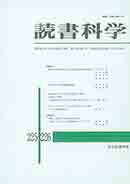Volume 57, Issue 3-4
Displaying 1-9 of 9 articles from this issue
- |<
- <
- 1
- >
- >|
-
2015Volume 57Issue 3-4 Pages cover1-
Published: October 30, 2015
Released on J-STAGE: March 16, 2018
Download PDF (108K) -
2015Volume 57Issue 3-4 Pages TOB1-
Published: October 30, 2015
Released on J-STAGE: March 16, 2018
Download PDF (143K)
Original Articles
-
2015Volume 57Issue 3-4 Pages 47-54
Published: October 30, 2015
Released on J-STAGE: January 12, 2017
Download PDF (470K) -
2015Volume 57Issue 3-4 Pages 55-62
Published: October 30, 2015
Released on J-STAGE: January 12, 2017
Download PDF (343K) -
2015Volume 57Issue 3-4 Pages 63-75
Published: October 30, 2015
Released on J-STAGE: January 12, 2017
Download PDF (447K) -
2015Volume 57Issue 3-4 Pages 76-88
Published: October 30, 2015
Released on J-STAGE: January 12, 2017
Download PDF (607K)
Reading Guidance Report
-
 2015Volume 57Issue 3-4 Pages 89-100
2015Volume 57Issue 3-4 Pages 89-100
Published: October 30, 2015
Released on J-STAGE: January 12, 2017
Download PDF (474K)
-
2015Volume 57Issue 3-4 Pages Regulation-
Published: October 30, 2015
Released on J-STAGE: March 16, 2018
Download PDF (158K) -
2015Volume 57Issue 3-4 Pages Colophon1-
Published: October 30, 2015
Released on J-STAGE: March 16, 2018
Download PDF (113K)
- |<
- <
- 1
- >
- >|
